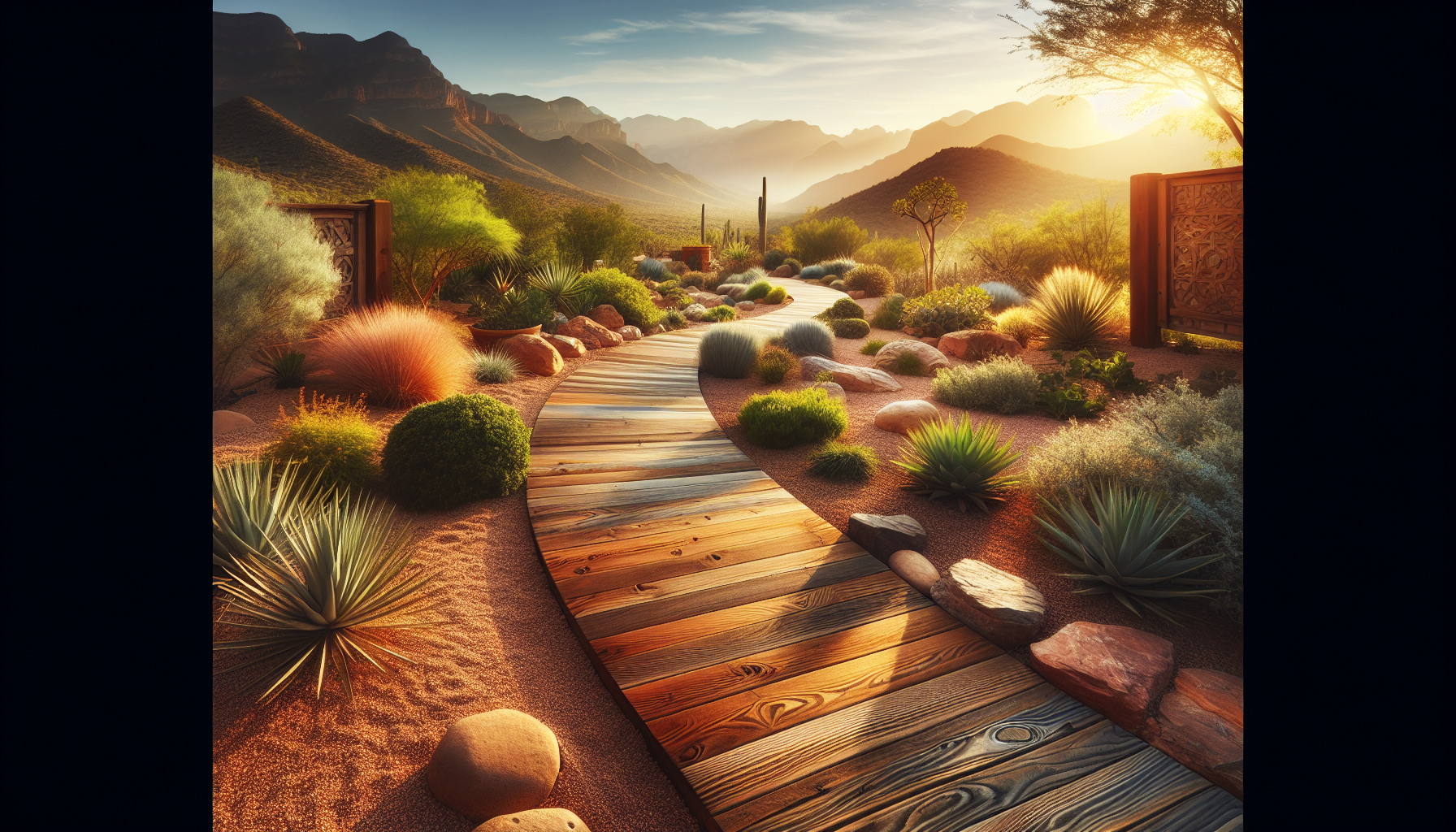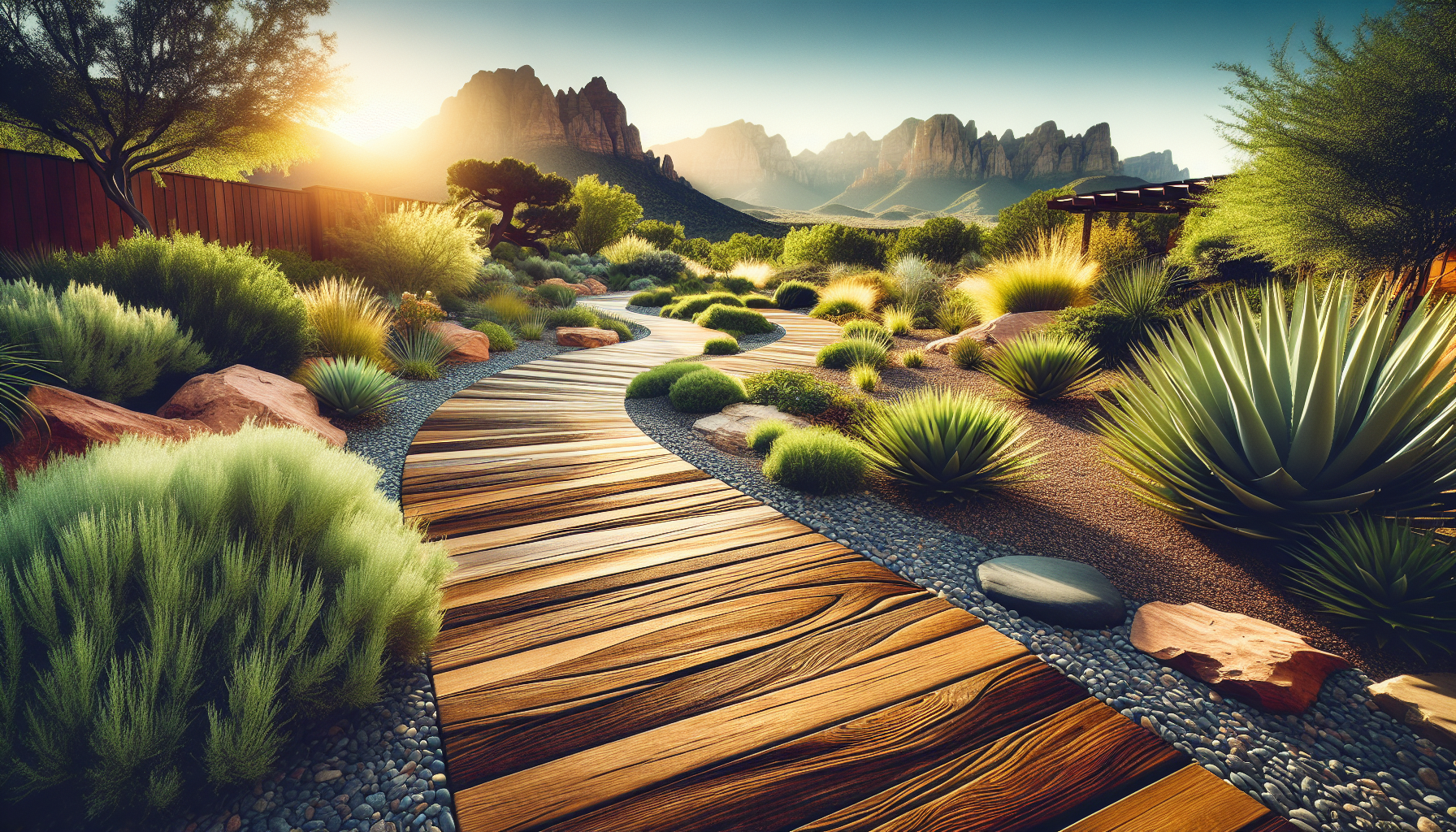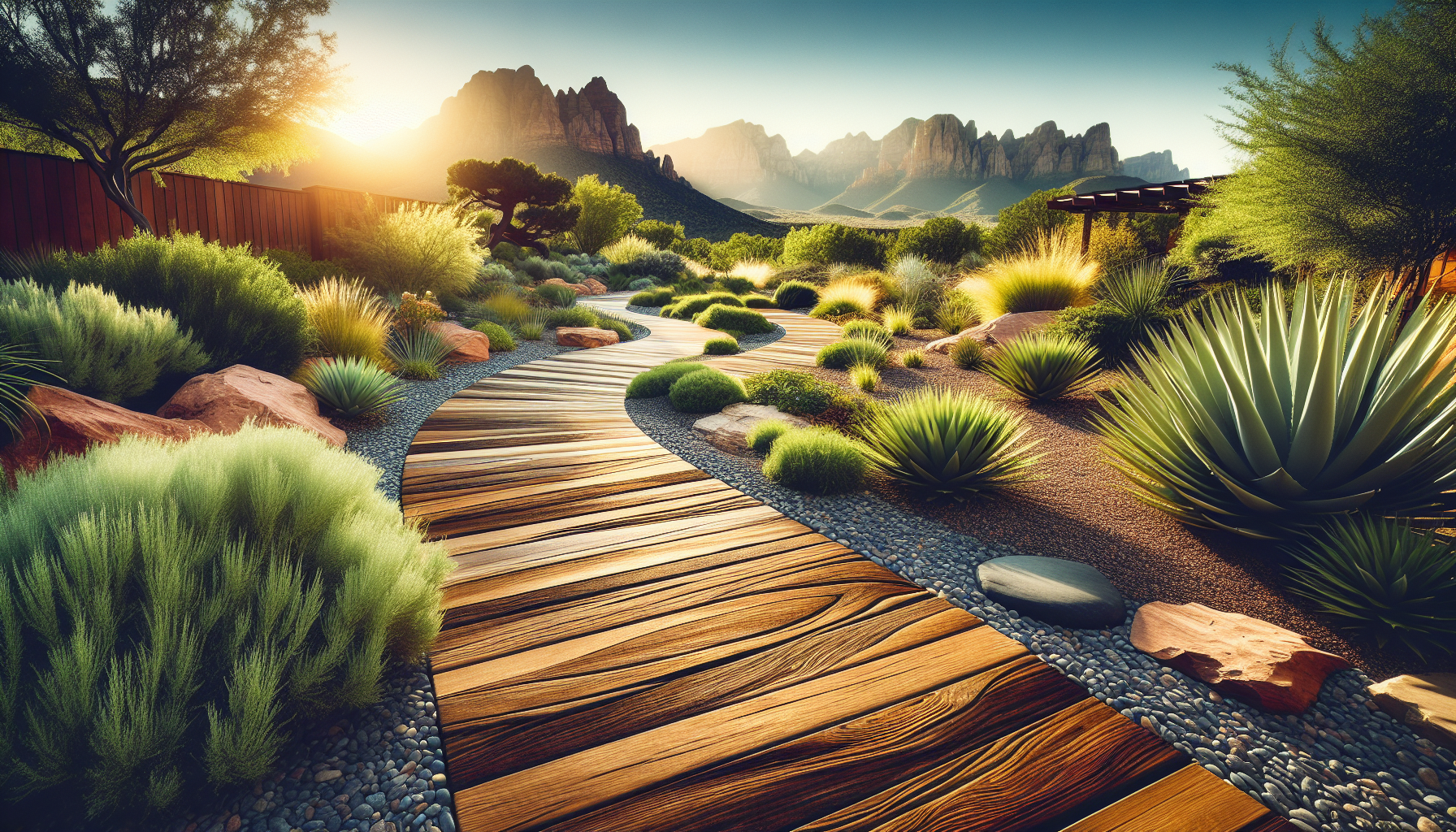What would your yard look like with a beautiful wooden pathway enhancing its natural beauty? Imagine walking along a pathway that guides you through your garden or yard, harmonizing with the landscape while adding a touch of elegance and functionality. You may also find that installing a wooden pathway can significantly improve accessibility, making your outdoor space more inviting and usable. Let’s explore how hardscaping can be effectively used for wooden pathway installation near Mesa.

The Allure of Mesa, Arizona
Mesa, Arizona, is a city known for its rich history, vibrant culture, and stunning desert landscapes. Located just east of Phoenix, Mesa offers residents a unique blend of modern living and small-town charm. You can enjoy attractions such as the Mesa Arts Center, where you can appreciate various forms of art, or visit the nearby Usery Mountain Regional Park, perfect for hiking and enjoying Arizona’s natural beauty.
The climate in Mesa is typically sunny and dry, making it an ideal location to consider outdoor enhancements like hardscaping. The warm temperatures allow for extended use of outdoor spaces, lending themselves beautifully to features like wooden pathways. The choice of materials and designs can be tailored to fit the aesthetic of your home and your personal style, providing both beauty and functionality.
As you think about your outdoor spaces, it’s a good time to explore how hardscaping elements, especially wooden pathways, can transform your garden or yard into a tranquil retreat.
Understanding Hardscaping
Hardscaping refers to any non-plant elements used in landscaping, such as stone, concrete, and wood. These elements help define your outdoor space and can add structure and form. Hardscaping can include features like patios, decks, retaining walls, and pathways, enhancing both the aesthetics and functionality of your yard.
Using hardscaping for pathways can:
- Create a clear walking route in your garden
- Improve accessibility for guests and family members
- Add visual interest and a focal point to your outdoor space
- Reduce yard maintenance by minimizing grass and dirt exposure
When considering a wooden pathway, think about how it will harmonize with existing landscaping features. The natural look of wood blends beautifully with various plants and flowers, offering a seamless transition from hard surfaces to green elements.
Benefits of Wooden Pathways
Opting for a wooden pathway comes with numerous benefits. Here are a few aspects to consider:
-
Aesthetic Appeal: Wooden pathways offer a warm, inviting look that complements natural surroundings. You can choose colors and finishes that match your home and landscaping.
-
Functionality: Wooden pathways provide a stable and durable surface for walking, making it easier to navigate uneven ground. They are also less likely to become muddy after heavy rains compared to soil paths.
-
Cost-Effectiveness: Compared to stone or brick options, wooden pathways can be a more budget-friendly solution, especially when selecting appropriate wood types.
-
Flexibility: Wood allows for various design choices. You can create straight paths or winding trails, depending on the layout of your garden.
-
Eco-Friendliness: When sourced sustainably, wood is a renewable resource, making wooden pathways a more environmentally friendly choice compared to other materials.
Given Mesa’s climate and natural beauty, wooden pathways can enhance your yard’s charm while providing practical benefits.
Planning Your Wooden Pathway Installation
Creating a wooden pathway starts with careful planning. Here’s a step-by-step guide to ensure a successful installation.
Step 1: Define Your Pathway’s Purpose
Before you start, think about how the pathway will be used. Will it lead to a seating area, a garden, or provide access to a shed? Knowing the purpose will help you decide the path’s location, width, and design.
Step 2: Choose Your Location
Walk your yard and visualize where the pathway will go. Consider existing plants, trees, and natural features. Make sure the location doesn’t interfere with any utility lines or drainage areas, as you want to ensure the safety and integrity of your installation.
Step 3: Determine the Path Width
The width of your pathway depends largely on its function and expected usage. A typical width for a single-person pathway is around 2 to 3 feet, while a wider path (4 to 5 feet) works better for two people walking side by side.
Step 4: Plan the Design
Design the pathway based on your personal style and garden layout. You can opt for straight lines or curves, with options to include turns and different shapes. Sketching your plan can help visualize the design.
Step 5: Select Materials
Choosing the right type of wood is essential for durability and weather resistance. Common options include cedar, redwood, and pressure-treated pine. Each type has its attributes regarding aesthetics and longevity. Cedar and redwood resist rot and insects naturally, making them great choices for outdoor use.
Step 6: Obtain Permits if Necessary
Depending on the scope of your project and local regulations, you may need to obtain permits before starting construction. Check with your local authorities to ensure compliance.
Step 7: Gather The Required Tools and Materials
You will need:
- Wooden planks or composite material
- Stakes
- String or garden twine
- Shovel
- Level
- Drill or screws
- Hammer
- Landscaping fabric (optional)
- Aggregate or gravel (optional)
Step 8: Measure and Mark the Pathway
Use stakes and string to outline the shape of your pathway. This helps visualize the area and ensures accurate placement.
Step 9: Prepare the Ground
Clear the marked area of any vegetation, rocks, or debris. If necessary, level the ground, ensuring it’s smooth and even for your pathway.
Step 10: Install the Base
You can choose to lay gravel or use landscaping fabric to prevent weeds from growing up through the pathway. This step not only enhances stability but also allows for better drainage.
Step 11: Lay the Wooden Planks
Position the wooden planks in the designated area. Start from one end and work your way to the other, ensuring that the planks are level and evenly spaced. For stability, use screws to secure the planks in place.
Step 12: Finish the Edges
To give your pathway a polished look, consider adding edge border materials, such as bricks or stones, around the pathway. This prevents soil erosion and maintains the integrity of your pathway.
Step 13: Treat the Wood
Applying a protective sealant or wood treatment can increase the lifespan of your wooden pathway. This step is crucial, especially in areas with high humidity or frequent rainfall, as it protects against rotting and decay.
Step 14: Regular Maintenance
To keep your pathway looking its best, regular maintenance is necessary. This can include cleaning debris, replacing damaged planks, and reapplying sealants as needed.
Additional Hardscaping Ideas for Your Yard
Incorporating hardscaping elements beyond just pathways can enhance your overall landscape design. Here are some ideas to consider:
Seating Areas
Creating a seating area with benches or chairs along your wooden pathway can provide a perfect spot to relax and enjoy the surroundings. You can include small tables or even a fire pit for cozy evenings.
Retaining Walls
Utilizing retaining walls can help manage slopes in your yard and create different levels. They can also serve as decorative features, using stones or bricks that complement your wooden pathway.
Decorative Planters
Adding planters or raised garden beds alongside or at the ends of your wooden pathway can introduce color and vibrancy. Choose plants that thrive in your climate and consider varying heights for visual interest.
Lighting Features
Incorporating lighting along your pathway enhances safety and adds charm in the evenings. Solar lights or low-voltage lighting options can effectively illuminate your pathway without requiring extensive installation.
Water Features
If space allows, consider adding a small water feature, such as a fountain or pond, adjacent to your pathway. The sound of flowing water can enhance the atmosphere and create a soothing environment.

Why Choose Xclusive Home Services
When it comes to hardscaping and wooden pathway installation in Mesa, you can trust Xclusive Home Services for all your needs. Founded in 2025, this company has quickly established itself as a leading provider of home services, including hardscaping. With their expertise, you can create a beautiful wooden pathway that fits your vision and enhances your outdoor space.
Their team of skilled professionals will work closely with you to design and install a solution that meets your needs. Whether you want to revamp your backyard or create an inviting entryway, Xclusive Home Services has the know-how to help.
Reach out to Xclusive Home Services at:
Address:
14505 N. Hayden Rd., Ste. 101
Scottsdale, AZ 85260
Phone:
(602) 341-5545
Email:
management@xclusivehomeservicesco.com
Investing in your outdoor space is a fantastic way to enhance your home’s curb appeal, improve usability, and create a serene environment. With the right planning and help from professionals like Xclusive Home Services, your vision for a wooden pathway can come true, adding charm and functionality to your yard near Mesa.
Conclusion
What do you envision for your outdoor space? A stunning wooden pathway may be just what you need to pull your garden together. With its multitude of benefits, practical installation steps, and the potential for added features, it can transform how you experience your yard. A well-planned wooden pathway not only provides beauty but also enhances the value of your home and invites you to enjoy the great outdoors.

